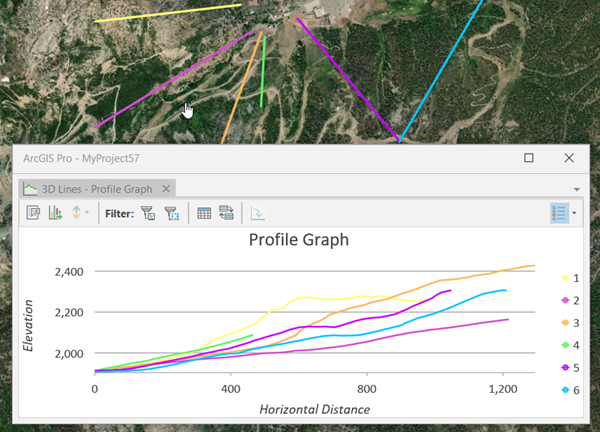Available with 3D Analyst license.
Profile graphs allow you to visualize elevation (z) or measure (m) change over a continuous horizontal distance using 3D line geometry. Visualizing this change with a profile graph allows the change to be displayed simultaneously for multiple 3D line features. You can make a profile graph for any 3D line layer in the Contents pane.
Note:
- A profile graph can be viewed without an ArcGIS 3D Analyst extension license, but the creation of a profile graph requires an ArcGIS 3D Analyst extension license.
- A profile graph supports a maximum of 1000 lines. If there are more than 1000 line features in the layer, select at least 1 and at most 1000 of them. Only the selected features will be graphed. If there are 1000 or fewer features, you can optionally select 1 or more to be graphed.
- Features that are not visible due to a definition query or other filters are not counted in the above-mentioned numbers and are not graphed.
- Once you create a profile graph, you cannot add or remove lines from that particular graph. You can change the lines that are displayed in the chart window using the graph selection or extent filter, and you can switch an individual line between visible and hidden by clicking its corresponding graphic in the graph's legend. However, the lines in the graph will always be a subset of the original lines used to build the graph. To graph a different set of lines, create a new profile graph.
A profile graph can be used to display the result of the Line Of Sight geoprocessing tool; visible and invisible portions of the output lines will be arranged to make a continuous graph. If, before running the tool, you choose to output graphing attributes (additional point data) with the output lines, the profile graph can display observer, target, and obstruction points as well as connecting lines (from observer to target). The default is to output this information from the Line Of Sight geoprocessing tool.
In addition, a profile graph can chain together (display end to end) separate line features that meet at their end vertices. If, for example, you have a road or stream the centerline of which has been split into separate features, the separate features can be displayed end to end.
The color and thickness of lines in the graph will match the color and thickness of the lines in the map or scene.
All of the factors that go into creating the chart are saved with the project. When you save the project, close it, and open it again, the contents of the chart remain the same.
Chart Properties pane
The Chart Properties pane consists of multiple tabs; the two tabs specific to profile graphs are the Data and Axes tabs. To access the Chart Properties pane, click the Properties button in the upper corner of the chart window.
Data tab
The Data tab includes the sections described below.
General
The General section consists of a toggle button to enable or disable tracking of the cursor and an expandable Display Options section. In the Display Options section, there is a drop-down list of what can be displayed in the y-axis of the chart, and a drop-down list of display styles.
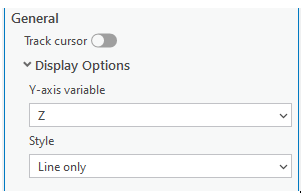
Turning on the Track cursor toggle button displays a tracking circle (a point overlay drawn as a small white circle) in the map or scene that indicates the position of the cursor in the chart. The tracking circle moves in the map or scene as the cursor is moved in the chart. In the chart, a vertical line marker moves with the cursor, and a label indicates the horizontal distance from the beginning of the line. If there is more than one line displayed in the chart, one tracking circle will appear for each line in the chart. If the cursor moves out of range of the line in the chart, the tracking circle will disappear. When the cursor moves off of the chart, or this option is turned off on the Chart Properties Data tab, all of the tracking circles will disappear.
You can select Z or M from the Y-axis variable drop-down menu. Each vertex of a 3D line (Polyline Z) has a z-value (elevation) and, optionally, an m-value (measure). M-values, for example, can be used to represent toxicity or oxygen levels along a route or river.
You can select an option from the Style drop-down menu: Line only, Line and vertices, or Fill.
The following is an example of the Line only option:

The following is an example of the Line and vertices option:

The following is an example of the Fill option:

Directionality
The Directionality section relates to whether lines are drawn in the chart from first vertex to last vertex or vice versa. This section consists the Flip direction toggle button and the Direction preference field drop-down list. Flipping the direction will cause all lines drawn in the chart to be drawn in the opposite direction.

You can optionally select a Direction preference field value. The drop-down list will contain all integer fields of the line feature class belonging to the feature layer. A value of 1 in the field will cause the line to always be drawn from first vertex to last vertex, and a value of -1 in the field will cause the line to always be drawn from last vertex to first vertex; all other values or null are ignored. Specifying a field and supplying values can impact chaining.
Direction preference is ignored for Line Of Sight output profile graphs. The Direction preference field option is hidden when the feature class consists of Line Of Sight output.
Line Of Sight Output
The Line Of Sight Output section relates to graphing output from the Line Of Sight tool; it only appears if the output includes the SourceOID, VisCode, and TarIsVis fields. These fields are automatically added to the output of the Line Of Sight tool.

This section includes the Points and Connecting line check boxes. Both depend on the output having the additional OBSERVERZ, TARGETZ, and OBSTR_DIST fields (referred to in the Line Of Sight tool as graphing attributes). For each sight line used as input to the Line Of Sight tool, there is typically one visible line of sight and one invisible line of sight. If no multipatch features were input to the tool, the output lines of sight represent a profile of the surface. If multipatch features were among the input data, the lines of sight run along an imaginary straight 3D line from the observer to the target.
The Points and Connecting line options are described as follows:
- Points—Check this option to display observer, target, and obstruction points. The observer and target points take into consideration any vertical offsets that were applied when the Line Of Sight tool was run. The obstruction point, if any, lies along an imaginary straight 3D line connecting the observer point to the target point.
- Connecting line—Check this option if you want a line connecting the observer point to the target point to be drawn for each source sight line.
If the observer or target point has a vertical offset and is higher than any vertex along the visible or invisible line, you may not see the point. You can increase the y-axis maximum value on the Axes tab to bring the point or points into view.
The following example of three pairs of visible and invisible lines results from the Line Of Sight tool output, with points and connecting lines displayed. In this case, two of the pairs are identical, so the lines give the impression of there being only two pairs.

Note:
Offsets were added at both the observer and target points so that the points are elevated in the graphic above. See Line Of Sight for more details.
Chaining
The Chaining section deals with chaining lines in the chart, meaning that they are displayed end to end, rather than each one starting from zero on the x-axis. This section only appears when there is more than one line and the line feature class doesn't contain SourceOID, VisCode, and TarIsVis fields. These fields are the output from the Line Of Sight geoprocessing tool.
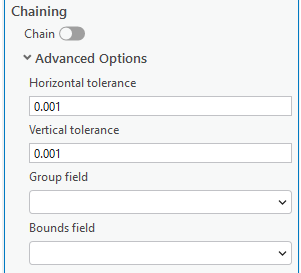
This section consists of the Chain toggle button that is used to turn chaining on or off, and the Advanced Options section. There are four parameters in the Advanced Options section: Horizontal tolerance, Vertical tolerance, Group field, and Bounds field.
Lines are connected if their end vertices are located at the same location (that is, co-located). A chain might typically connect two lines where the last vertex of the first line is co-located with the first vertex of the second line. But chaining could also connect the second line to the first line even if the last vertex of the second line is co-located with the last vertex of the first line, unless a directionality preference value of 1 is specified for the second line to prevent such connection during chaining, in which case the second line would be part of another chain.
Whether end (that is, first or last) vertices are deemed to be co-located depends in part on the tolerance values. The Horizontal tolerance option value is the maximum 2D distance between an end (first or last) vertex of one line and an end vertex of another line to chain them together in the graph. The Vertical tolerance option value is the maximum vertical distance between the two end vertices. Both the horizontal and vertical conditions must be met for the end vertices to be considered as being co-located. The default is 0.001 for each of the two tolerances.
If more than two lines meet at a juncture, the chaining stops unless group fields are specified and allow for an explicit path for the chain, or directional preference is specified and gives an unambiguous path along which to continue.
You can select a Group field value from the drop-down list. This can be either an integer field or a string field. When you specify a Group field value, one or more chains can be created from lines having the same Group field value, though they still have to meet geometric criteria.
You can select a Bounds field value from the drop-down list. This must be an integer field. If a line feature has the value 1, this line can only be the head (beginning) of a chain, even if it is the only line in the chain. If a line feature has the value 2, this line can only be the tail (end) of a chain. If a line feature has the value 3, this line can only be both the head and the tail of a chain, meaning that it will form a chain consisting of just that one line.
Lines that are not chained are displayed the same as usual, in the same graph with the chained lines; they are in effect chains consisting of just one line. There can be multiple chains in the graph.
The following profile graph shows individual lines (before the Chain option is turned on):
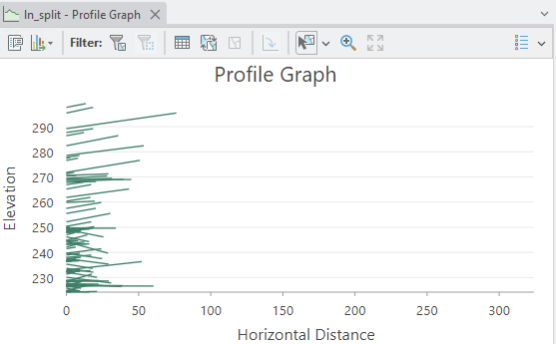
The following profile graph shows a chained line (after the Chain option is turned on):

Multipart lines should appear with gaps if there are gaps between parts. Cursor tracking should behave logically in multipart lines with gaps and in chains. Selection plays no role in chaining.
Axes tab
Profile graphs consist of continuous horizontal distance on the x-axis and either elevation (z) or measure (m) on the y-axis. The horizontal distance refers to the distance from the beginning of each 3D line when projected onto an imaginary horizontal plane, measured along the line. This applies whether or not all vertices are collinear in this horizontal projection. The automatic adjustment of visible and invisible lines that are output from the Line Of Sight tool, or the optional chaining of lines that are not from that output, will cause some or most lines to not appear to begin at zero on the x-axis.
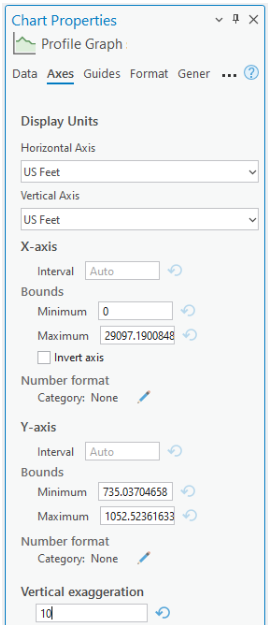
The units of measure for the horizontal and vertical axes are displayed in drop-down menus on the Axes tab in the Chart Properties pane. When a profile graph is created, its unit of measure is set to that of the dataset. If no unit of measure is assigned, the unit of measure will be meters (the default value). After a profile graph is created, you can select other units from the drop-down menus, and the profile graph and the axes will be redrawn accordingly.
Invert axis
The Invert axis option only impacts the x-axis (horizontal axis). When checked, the graph will be drawn from right to left rather than from left to right.
Vertical exaggeration
When a profile graph is created, it fills the chart window. When you resize the window, the profile graph is redrawn, which typically alters the apparent vertical exaggeration. You can edit the minimum and maximum bounds for either of, or both, the x-axis and y-axis. This also typically alters the apparent vertical exaggeration.
You can effect a vertical exaggeration by providing a value for the Vertical exaggeration option. To remove the value, click the Reset button next to the text box.
A value of 1 means that the vertical scale will be the same as the horizontal scale. Larger values exaggerate the vertical scale, for example, the graph will be taller or inflated in the vertical direction, and smaller values will shrink the vertical scale. Leaving this option blank, by clicking the Reset button, enables the charting system to automatically fit the y-axis values, and the y-axis scale will depend on the window shape and the values specified for axes minima and maxima, if any.
If a value is specified for this option, the graph will be centered vertically.
Appearance
You can edit the default properties of a profile graph and change its appearance in several ways.
Titles and description
The default profile graph title is based on the name of the feature layer being graphed. The title and axis labels can be edited on the General tab in the Chart Properties pane. You can also provide a Description value, which is text that appears at the bottom of the chart window.
Extent and clipping
If you turn on the Extent filter, each of the lines that appear at least partially in the visible portion of the map also appear in the chart window. The features will be clipped by the extent of the visible portion in the map. This is only available in a map view, not a scene view. This functionality is also supported in layouts.
Color
The color of each line in a profile graph will be the same as the color of the line in the map display. If the current renderer is Single Symbol, all lines will be the same color. To use different colors for different lines, change the renderer to Unique Value.
Legend
The legend displays one small graphic for each line in a profile graph using the same color as the line; the nature of the graphic in the legend depends on the display style specified on the Data tab. Next to each graphic is a number, which is the ObjectID, FeatureID, or OID value of the point. By default, the legend is not displayed when a new profile graph is created. A legend is not displayed when there is one line in a profile graph.
Note:
The legend can be shown or hidden using the toggle button in the upper corner of the chart window.Selection
You can select a line by clicking any of the following:
- The line in the map display
- The row in the line layer's attribute table
- The line in the profile graph
- The legend item in the profile graph
Note:
The first click on a line's legend item causes the line to disappear from the profile graph, and a second click on the same legend item causes the line to reappear.
Export As Table
A table consisting of three columns and multiple rows will be exported. The table will consist of the following fields:
- id—The object ID of the line
- x—The horizontal distance along the line
- y—Either the z (elevation) at the vertex or the m (measure) value at the vertex
Tooltips
When you hover over a line in a chart, a tooltip presents information about the line. The y-axis value is displayed for the vertex that immediately precedes that section of the line. If you hover over an obstruction point, that point's information appears in the tooltip.
Example
The example below shows a profile graph that displays elevation change over the length of the input 3D lines.
- X-axis—Horizontal distance
- Y-axis—Elevation
